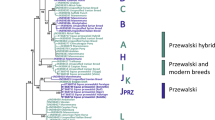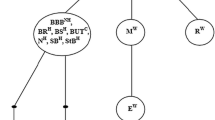Abstract
The noncoding region between tRNAPro and the large conserved sequence block is the most variable region in the mammalian mitochondrial DNA D-loop region. This variable region (ca. 270 bp) of four species of Equus, including Mongolian and Japanese native domestic horses as well as Przewalskii's (or Mongolian) wild horse, were sequenced. These data were compared with our recently published Thoroughbred horse mitochondrial DNA sequences. The evolutionary rate of this region among the four species of Equus was estimated to be 2–4 × 10−8 per site per year. Phylogenetic trees of Equus species demonstrate that Przewalskii's wild horse is within the genetic variation among the domestic horse. This suggests that the chromosome number change (probably increase) of the Przewalskii's wild horse occurred rather recently.
Similar content being viewed by others
References
Anderson S, de Bruijn MHL, Coulson AR, Eperon IC, Sanger F, Young IG (1982) Complete sequence of bovine mitochondrial DNA. Conserved features of the mammalian mitochondrial genome. J Mol Biol 156:683–717
Aquadro CF, Greenberg BD (1982) Human mitochondrial DNA variation and evolution: analysis of nucleotide sequences from seven individuals. Genetics 103:287–312
Benirschke K, Malouf N, Low RJ, Heck H (1965) Chromosome complement differences between Equus caballus and Equus przewalskii, Poliakoff. Science 148:382–383
Bökönyi S (1974) History of domestic mammals in Central and Eastern Europe. Akadémiai Kiadó, Budapest, 230–296
Brown WM, George M Jr, Wilson AC (1979) Rapid evolution of animal mitochondrial DNA. Proc Natl Acad Sci USA 76:1967–1971
Bush GL, Case SM, Wilson AC, Patton JL (1977) Rapid speciation and chromosomal evolution in mammals. Proc Natl Acad Sci USA 74:3942–3946
Cann RL, Brown WM, Wilson AC (1984) Polymorphic sites and the mechanism of evolution in human mitochondrial DNA. Genetics 325:31–36
Chang D, Clayton DA (1985) Priming of human mitochondrial DNA replication occurs at the light strand promoter. Proc Natl Acad Sci USA 82:351–355
Clegg JB (1974) Horse hemoglobin polymorphism. Ann NY Acad Sci 241:61–69
Fitch WM (1977) On the problem of discovering the most parsimonious tree. Am Naturalist 111:223–257
George M Jr, Ryder OA (1986) Mitochondrial DNA evolution in the genus Equus. Mol Biol Evol 3:535–546
Groves CP, Willoughby DP (1981) Studies on the taxonomy and phylogeny of the genus Equus. 1. Subgeneric classification of the recent species. Mammalia 45:321–354
Higgins DG, Bleasby AJ, Fuchs R (1992) CLUSTAL V: improved software for multiple sequence alignment. Comput Appl Biosci 8:189–191
Higuchi RG Wrischnik LA, Oakes E, George M, Tong B, Wilson AC (1987) Mitochondrial DNA of the extinct quagga: relatedness and extent of postmortem change. J Mol Evol 25:283–287
Ishida N, Hasegawa T, Takeda K, Sakagami M, Onishi A, Inumaru S, Komatsu M, Mukoyama H (1994) Polymorphic sequence in the D-loop region of equine mitochondrial DNA. Anim Genet 25:215–221
Kaminski M (1979) The biochemical evolution of the horse. Comput Biochem Physiol 63B:175–178
Kimura M (1980) A simple method for estimating evolutionary rate of base substitutions through comparative studies of nucleotide sequences. J Mol Evol 16:111–120
Kumar S, Tamura K, Nei M (1993) MEGA: Molecular evolutionary genetics analysis, version 1.0. The Pennsylvania State University, University Park, PA
Lindsay EH, Opdyke ND, Johnson ND (1980) Pliocene dispersal of the horse Equus and late Cenozoic mammalian dispersal events. Nature 287:135–138
MacFadden BJ (1992) Fossil horses: systematics, paleobiology, and evolution of the family Equidae. Cambridge University Press, Cambridge
Mohr E (1971) The Asiatic wild horse. JA Allen, London, pp 26–33.Translated by
Goodall DM from “Das Urwildpferd,” A Zaisen Verlag, Wittenberg Lutherstadt, 1970
Nei M, Li WH (1979) Mathematical model for studying genetic variation in terms of restriction endonucleases. Proc Natl Acad Sci USA 76:5269–5273
Nei M, Tajima F (1983) Maximum likelihood estimation of the number of nucleotide substitutions from restriction site data. Genetics 105:207–217
Nerurkar VR, Song KJ, Saitou N, Mallan RR, Yanagihara R (1993) Interfamilial and intrafamilial genomic diversity of human T lymphotropic virus type I strains from Papua New Guinea and the Solomon Islands. Virology 196:506–513
Nowak RM, Paradiso JL (1983) Walker's mammals of the world, 4th edition. The Johns Hopkins University Press, Baltimore
Nozawa K (1992) Origin and ancestry of native horses in Eastern Asia and Japan. Jpn J Equine Sci 3:1–18
Ryder OA, Epel NC, Benirschke K (1978) Chromosome banding studies of the Equidae. Cytogenet Cell Genet 20:323–350
Ryder OA, Starkes RS, Starkes MC, Clegg JB (1979) Hemoglobin polymorphism in Equus przewalskii and E. caballus analyzed by isoelectric focusing. Comput Biochem Physiol 62B:305–308
Saitou N, Nei M (1987) The neighbor-joining method: a new method for reconstructing phylogenetic trees. Mol Biol Evol 4:406–425
Saitou N, Ueda S (1994) Evolutionary rate of insertions and deletions in non-coding nucleotide sequences of primates. Mol Biol Evol 11:504–522
Sambrook J, Fritsch EF, Maniatis T (1989) Molecular cloning: a laboratory manual, 2nd ed. Cold Spring Harbor Laboratory Press, Cold Spring Harbor, NY, 9.14–9.23
Sanger F, Niklen S, Coulson AR (1977) DNA sequencing with chain-terminating inhibitors. Proc Natl Acad Sci USA 74:5463–5467
Simpson GG (1951) Horses: the story of the horse family in the modern world and through sixty million years of history. Oxford University Press, New York
Swofford DL (1993) PAUP: phylogenetic analysis using parsimony, version 3.1.1. Computer program distributed by the Illinois Natural History Survey, Champaign, IL
Tamura K and Nei M (1993) Estimation of the number of nucleotide substitutions in the control region of mitochondrial DNA in humans and chimpanzees. Mol Biol Evol 10:512–526
Trommerhausen-Smith A, Ryder OA, Suzuki Y (1979) Bloodtyping studies of twelve przewalskii's horses. Intl Zoo Yrbk 9:224–227
Vigilant L, Stoneking M, Harpending H, Hawkes K, Wilson AC (1991) African populations and the evolution of human mitochondrial DNA. Science 253:1503–1507
Walberg MW, Clayton DA (1981) Sequence and properties of the human KB cell and mouse L cell D-loop regions of mitochondrial DNA. Nucleic Acids Res 9:5411–5421
Yonekawa H, Moriwaki K, Gotoh O, Miyashita N, Matsushima Y, Shi L, Cho WS, Zehn XL, Tagashira Y (1988) Hybrid origin of Japanese mice “Mus musculus molossinus”: evidence from restriction analysis of mitochondrial DNA. Mol Biol Evol 5:63–78
Author information
Authors and Affiliations
Additional information
Correspondence to: N. Ishida
Rights and permissions
About this article
Cite this article
Ishida, N., Oyunsuren, T., Mashima, S. et al. Mitochondrial DNA sequences of various species of the genus Equus with special reference to the phylogenetic relationship between Przewalskii's wild horse and domestic horse. J Mol Evol 41, 180–188 (1995). https://doi.org/10.1007/BF00170671
Received:
Accepted:
Issue Date:
DOI: https://doi.org/10.1007/BF00170671




